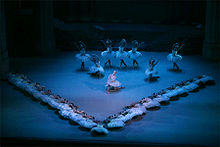Corps de ballet

The corps de ballet ([ kɔʀdəbalɛ ] French “unity, group in ballet ”) is an ensemble of dancers at a theater that performs choral tasks, in contrast to the soloists who dance pas de deux . - In a broader sense, the term is also used for ballet companies and then includes all members of the company.
history
The stage dance has evolved from the ballroom dancing developed which belonged to general education, and gradually replaced in the 18th century by him. That is why dance ensembles are a reflection of the dancing court society even in later ballets.
The fact that a corps de ballet only dances and does not perform other (singing or speaking) choral tasks is relatively new in the history of theater . In the 18th century, for example in the ballet operas ( opéra-ballet ) by Jean Philippe Rameau , there were often choirs singing and dancing at the same time. In a certain way, this tradition has survived from operettas to modern musicals . Until the first third of the 19th century, such tasks were often carried out by the other members of the theater, e.g. B. Acting, and do not require highly developed dancing skills. In his contract as choir conductor at the Würzburg Theater in 1833, the composer Richard Wagner was still obliged to perform on stage in the ballet.
Since the beginning of the 19th century, ballet has become increasingly independent from opera . Since the point dance had become a fundamental technique, choral tasks in ballet required specialized dancers. Since then, ballets have often taken place in the same house as the operas, but are separate from the operas. The “classic” corps de ballet, which acts in the background of the soloists, corresponds roughly to the professional opera choir in the opera. While ballet ensembles were still called choirs at the end of the 18th century, they were given the name corps de ballet in the 19th century, based on the Paris Opera .
In classical ballet since Giselle (1841), synchronous movements in symmetrical groups have been required by the corps de ballet (see e.g. Tableaux vivants ): harmony in technical perfection. The response to the military corps of the 19th century is not absurd : a perfectly organized, disciplined, well-coordinated group.
The corps de ballet is often structured hierarchically according to functions, at the Paris Opera, for example, into quadrilles , coryphées and sujets . At the Vienna Opera there is a division into dancers and mimics . The dancers of the Corps de ballet also perform solo tasks more often than opera choristers. Moving up from the corps de ballet to becoming a soloist was the normal route at a time when dancers started their careers in childhood and it is still possible today.
Since the 20th century, the highly professional subordination and conformity of the corps de ballet has often been questioned. His anonymity often appeared in contradiction to artistic individuality. That is why he has often been given individualized tasks and the distance to the soloists has been reduced. The dance groups in modern dance theater are often extreme counter-designs to the classical tasks of the corps de ballet.
literature
- Fiona Macintosh: Choruses, Community and Corps de ballet, in: Joshua Billings et al. (Ed.): Choruses, Ancient and Modern, Oxford Univ. Press 2013, pp. 309-325. ISBN 9780199670574